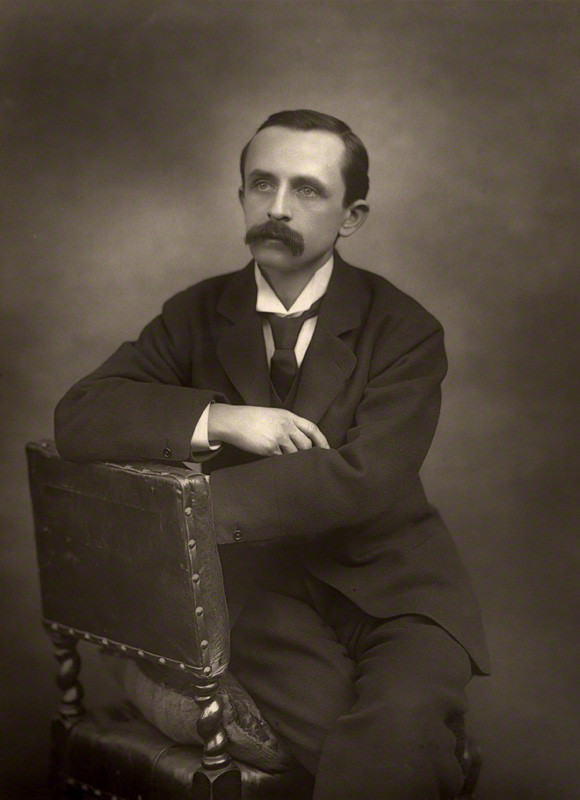Hogan’s Peter Pan shares a number of intertextual relationships with its hypotext. Perhaps most tangibly, it is a generical transposition of J.M. Barrie’s original play. Also, and partially related to this, it incorporates a number of elements of approximation from the original which can not entirely be understood as products of a generical transposition. Finally, the hypertext forms a bricolage of analogies to other, though arguably less prominently treated, hypotexts. This bricolage can, for obvious reasons, not be seen as a replication of a similar bricolage in Barrie’s original as will be shown below.
 |
| J.M. Barrie |
Hogan’s film is an obvious transposition in terms of genre. Although Peter Pan appeared as both novel and a variety of plays in Barrie’s lifetime, the original Peter Pan is a dramatic one. Thus, the transposition from one dramatic genre to another should be a comparatively easy one. This, of course, is belied by the several editorial choices Hogan would have to make. Which dramatic elements in the hypotext are so central that they should be received in the new genre and which can be excluded? As the next paragraphs will show, the simultaneous process of approximation would necessarily interfere in this process of transposition.
The Wendy character becomes more central as more time is allotted for her characterisation before Peter’s appearance and this process of making her more active and decisive is an approximation of gender roles. The Peter Pan character in appearance and personality represents a return to those of the hypotext after the moderation of the Disney version (iii). He appears older than in the hypotext; while he frequently describes himself as very young in the play and “has all his baby teeth”, he is played by a 14-year-old with a breaking voice in the film (iv). This is probably a move to make the character more relevant to a teenage audience. The Hook character appears more sinister, which partially is a similar return to the hypotext after Disney’s moderation, though Hogan’s Hook surpasses the original in cruelty. This may be due to changing tolerance for violence in the audience. Finally, the Aunt Millicent character is interpolated by Hogan to take on the disagreeable aspects of the parents, especially the father’s authoritative qualities. This process of making the parents more appealing might be in order to further emphasise the conflict between child- and adulthood so prevalent in the target audience.
 |
| Hook and Wendy |
Similarly, a light hue following Peter and the changing light reflecting Peter’s state of mind might be a more extensive approximation of the stage lights which would have been used in a staging of the original play (v). This and the increased use of digital animation caters for an audience accustomed to modern standards. It also helps reflect social relationships. The very vague romantic connection between Peter and Wendy in the play becomes a prominent feature in the film. Accompanied by romantic images and light their relationship receives a dimension which caters for teenage sexual tension (vi). Furthermore, the interpolated plotline of the kiss becomes a tool of approximation used to achieve this end.
Paul J. Hogan’s Peter Pan’s adaptive relationship to Barrie’s play is a complex one which has yet to be adequately discussed. The above paragraphs have shown how the editorial choices associated with the change of genre was determined by several processes of approximation. Hogan’s film appears more adapted to an pre-teen/ teenage audience with more romantic, sinister and violent features than the hypotext. Furthermore, technological advances has allowed Hogan to overcome some of the limitations of the stage, which must have influenced Barrie, but also retain and improve some of the features from the hypotext. Finally, the hypertext does draw on other sources than just the hypotext. As with Barrie’s protagonist, the representation of characters alludes to defining cultural products within particular areas, such as Stevenson’s Treasure Island.
Endnotes
(i) Hogan, P.J.; Peter Pan, 2003 (DVD). James Matthew Barrie;Peter Pan; or, The Boy Who Would Not Grow Up in James Matthew Barrie; Peter Pan and Other Plays, Oxford 2008.
(ii) Julie Sanders; Adaptation and Appropriation, London 2006
(iii) See Deborah Cartmell’s essay in Deborah Cartmell and Imelda Whelahan (eds.); The Cambridge Companion to Literature on Screen, Cambridge 2007: 167-180 for more on this.
(iv) Barrie 2008: 123, 145. In fact, in the novel Peter and Wendy Barrie also frequently draws attention to Pan’s “first teeth”.
(v) Hogan 2003: 1.23.00-1.33.00
(vi) Ibid: 53.00-56.00
(vii) Sanders 2006: 4
Pictures: 1, 2
Bibliography
Literature:
Barrie, James Matthew; Peter Pan; or, The Boy Who Would Not Grow Up in James Matthew Barrie; Peter Pan and Other Plays, Oxford 2008
Cartmell, Deborah and Whelahan, Imelda (eds.); The Cambridge Companion to Literature on Screen, Cambridge 2007
Sanders, Julie: Adaptation and Appropriation, London, 2006
Film:
Hogan, P.J.; Peter Pan 2003 (DVD)
No comments:
Post a Comment